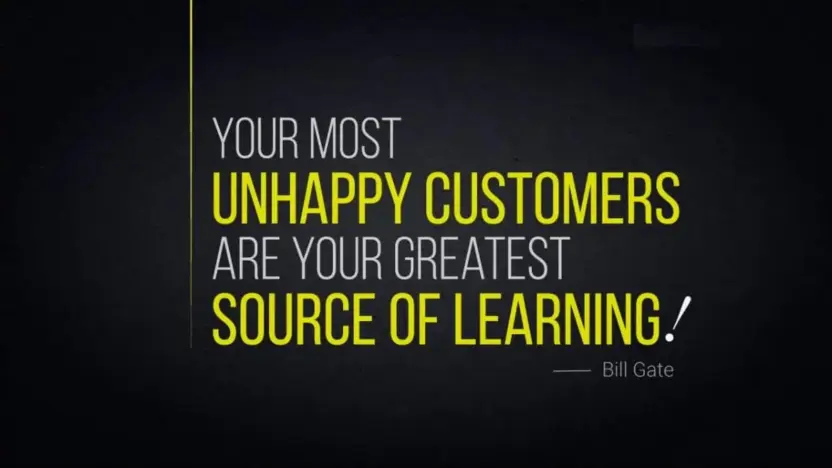The quote, “Your most unhappy customers are your greatest source of learning,” suggests that dissatisfaction, rather than being purely detrimental, holds invaluable insights for growth and improvement. This blog explores the layers of this statement, elucidating how businesses can transform customer discontent into a springboard for innovation, customer satisfaction, and sustained success.
Understanding Customer Discontent
Customer dissatisfaction can manifest for various reasons—poor product quality, inadequate service, unmet expectations, or simply a misalignment between what was promised and what was delivered. Each negative review or complaint is a direct feedback loop from those who interact closely with your offerings. It pinpoints specific areas where a business might not only be failing to meet expectations but also where it might be missing opportunities to excel.
The Learning Curve
Acknowledging that something isn’t working as intended is the first step toward improvement. Here’s how you can approach this:
- Immediate Response: Addressing customer complaints promptly and efficiently shows that you value their feedback and are committed to providing quality service.
- In-depth Analysis: Go beyond the surface complaint and analyze the underlying issues. Was it a one-off situation, or does it indicate a systemic problem?
- Engaging the Unhappy Customer: Involve them in the resolution process. This not only helps in rectifying the issue but can convert a dissatisfied customer into a loyal advocate.
Case Studies of Learning from Unhappy Customers
Numerous companies have turned customer complaints into success stories:
- A Tech Giant’s Turnaround: A leading technology company once faced widespread criticism over the poor battery life of their product. They launched an extended battery program that not only fixed the issue but also improved their customer service ratings dramatically.
- Fashion Retailer Reboot: A fashion retailer noted recurring complaints about their clothing sizes running too small. By overhauling their sizing charts and quality control, they regained customer trust and increased sales.
These examples demonstrate that listening to unhappy customers provides insights that can lead to significant business improvements.

Strategic Implementation of Feedback
The real challenge lies in how the feedback is implemented strategically:
- Incorporate Feedback into Business Processes: This can mean revising product designs, improving service protocols, or even rethinking customer interaction platforms.
- Training and Development: Equip your staff with the necessary skills to handle complaints effectively and to avoid similar issues in the future.
- Monitoring and Evaluation: Regularly review how changes have impacted customer satisfaction and be ready to make further adjustments.
Cultural Shift: Embracing Complaints as Opportunities
Cultivating a business culture that views customer complaints as opportunities rather than nuisances can transform the way your team approaches feedback. It fosters an environment of openness, innovation, and continuous improvement.
- Leadership Role: Leaders should model the importance of customer feedback by taking direct action on complaints.
- Reward System: Implement a system that rewards employees for successfully managing and resolving customer issues.
- Transparency: Be open about what is learned from customer feedback and how it’s being used to improve.
Technological Tools for Harnessing Customer Insights
In today’s digital age, various tools can help capture and analyze customer feedback effectively:
- Customer Relationship Management (CRM) Systems: These can track all customer interactions and feedback, providing a holistic view of customer satisfaction.
- Analytics Tools: Use data analytics to understand patterns and trends in customer feedback.
- Feedback Platforms: Tools like surveys, feedback forms, and community forums can be invaluable for gathering insights.
Conclusion
“Your most unhappy customers are your greatest source of learning” is not just a passive observation—it’s a proactive call to action. By embracing the uncomfortable truths revealed through customer dissatisfaction, businesses can pave the way for meaningful improvements, enhanced customer relationships, and ultimately, a stronger market position. Every complaint holds the kernel of potential growth, and those who listen, adapt, and learn will thrive in an ever-evolving business landscape.
Also Read: The man who moves a mountain begins by carrying away small stones



